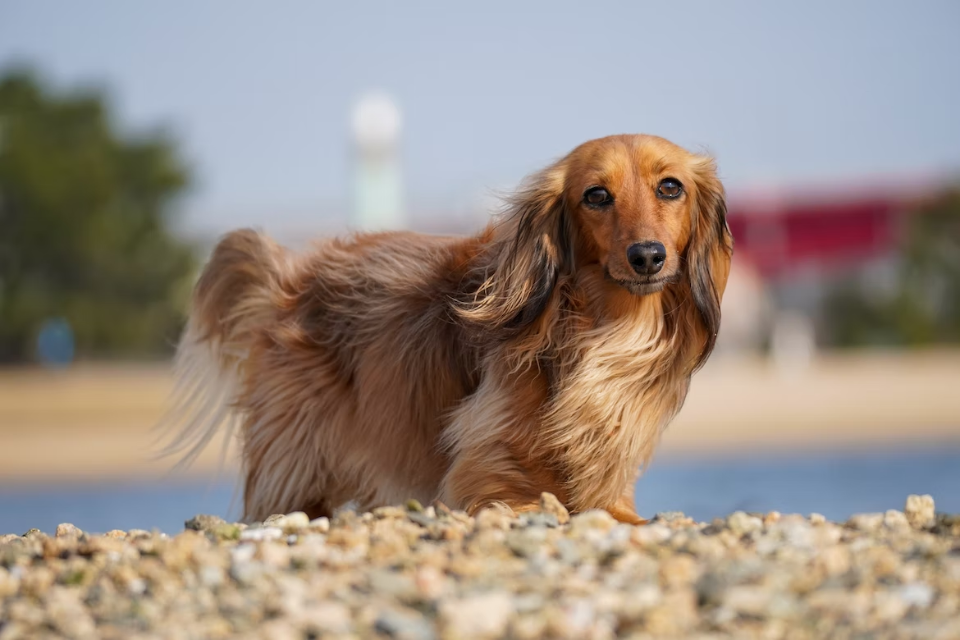Miniature Dachshunds are one of the most beloved small dog breeds. Known for their adorable looks and big personalities, these pups have captured the hearts of many dog lovers around the world. As an owner of several miniature dachshunds over the years, I have experienced firsthand the joys and responsibilities that come with owning these furry companions.
One important aspect of owning a female miniature dachshund is understanding when they can get pregnant. Breeding can be a rewarding experience, but it also requires careful consideration and attention to the dog’s health and well-being.
In this blog post, we will explore in-depth the reproductive cycle of miniature dachshunds, including the age at which they can get pregnant, signs that indicate they are in heat, and the risks and health concerns associated with breeding. By the end of this post, you will have a better understanding of when your miniature dachshund is ready for breeding and how to care for her during the process. So, let’s dive in!
Key Takeaways:
- Miniature dachshunds can get pregnant as early as six months old, but it is best to wait until they are at least a year old and fully matured.
- Signs of heat in miniature dachshunds include changes in behavior, bleeding, and swelling of the vulva.
- Mating and pregnancy in miniature dachshunds should be carefully planned and monitored by a veterinarian due to potential risks and health concerns.
Anatomy and reproductive cycle of miniature dachshunds
Understanding the anatomy and reproductive cycle of your miniature dachshund is crucial when it comes to breeding. Female miniature dachshunds, like all mammals, have reproductive systems that allow them to conceive and carry offspring. The reproductive cycle of miniature dachshunds can be broken down into four main stages: proestrus, estrus, diestrus, and anestrus.
During proestrus, which lasts for about 9-10 days, your dog’s body is preparing for mating. During this time, the female’s vulva will begin to swell, and she may start to show signs of discharge. She may also become more restless and agitated during this stage.
Estrus is the stage where your dog is most likely to become pregnant. It usually lasts around 5-7 days, and during this time, the discharge will become clearer and more viscous. Your dog’s behavior may also change during this stage, and she may become more affectionate and willing to mate.
Diestrus is the stage that follows estrus and lasts for approximately 60 days. If your dog has become pregnant, this is when the pregnancy will continue to develop. If not, your dog’s body will return to a state of rest.
Finally, anestrus is a period of rest and recovery for your dog’s reproductive system. This stage lasts for about 4-5 months, during which time your dog’s body will prepare for the next reproductive cycle.
It’s important to keep in mind that not all female miniature dachshunds will have the same reproductive cycle length, as it can vary from dog to dog. Additionally, there are risks associated with breeding too often, such as increased risk of health issues for the mother and offspring. As such, it’s important to consult with your veterinarian and ensure that you are breeding responsibly.
In addition to understanding the reproductive cycle, it’s also important to be familiar with the anatomy of your miniature dachshund. Females have a small, narrow pelvis, which can make delivery more difficult. This can lead to complications during birth, such as the need for a cesarean section.
Age at which miniature dachshunds can get pregnant
The age at which a miniature dachshund can get pregnant varies, but it is important to note that they should not be bred before they are fully mature. This can lead to complications for both the mother and the puppies. A good rule of thumb is to wait until the female dachshund is at least 2 years old before considering breeding her. By this age, she should be fully developed and mature enough to handle pregnancy and childbirth.
It is also important to note that age is not the only factor to consider when breeding a miniature dachshund. The female dog should also be in good health and have a stable temperament. Breeding a dog that is too young or unhealthy can lead to complications during pregnancy, such as difficulty giving birth, low birth weight puppies, and even death.
It is also important to consider the age of the male dachshund. Male dogs can begin breeding as early as 6 months old, but it is best to wait until they are fully matured, around 1-2 years old, before breeding them. This ensures that they are physically and mentally ready to handle the rigors of breeding.
Overall, it is important to consider the health and well-being of the miniature dachshund before breeding. Waiting until they are fully matured, typically around 2 years old, is a good rule of thumb. By doing so, you can help ensure a successful pregnancy and healthy puppies.
Signs that indicate a miniature dachshund is in heat
As an owner of a miniature dachshund, it is important to be able to recognize the signs that your dog is in heat. Knowing when your dog is fertile will help you prevent unwanted pregnancies or plan for a breeding.
The heat cycle of a female dog usually lasts for three weeks and can occur twice a year. The signs that indicate a miniature dachshund is in heat include:
- Swollen vulva: The vulva of your miniature dachshund will become swollen and enlarged during the heat cycle. This is one of the most obvious signs of heat.
- Discharge: Your dog may produce a bloody discharge from her vulva. This discharge is usually light in color at the beginning of the heat cycle and becomes darker and thicker towards the end.
- Changes in behavior: Your miniature dachshund’s behavior may change during the heat cycle. She may become more affectionate, anxious, or restless. She may also start to urinate more frequently.
- Attractiveness to male dogs: Your dog will become more attractive to male dogs during the heat cycle. Male dogs may start to follow your dog around or try to mount her.
- Licking: Your dog may start to lick her vulva more frequently during the heat cycle.
It is important to keep your miniature dachshund away from male dogs during the heat cycle to prevent unwanted pregnancies. You should also make sure to keep her in a secure area as male dogs may try to dig or jump over fences to reach her.
Mating and pregnancy
Once a female miniature dachshund is in heat and ready to mate, it’s important to consider several factors before allowing breeding to occur. Firstly, it’s important to ensure that both the male and female dachshunds are healthy and free from any hereditary diseases that could be passed down to their offspring. A responsible breeder will have the necessary health clearances for both parents before allowing breeding to occur.
It’s also important to consider the timing of breeding. A female dachshund’s heat cycle typically lasts around three weeks, but they are only fertile for a short period of time during that cycle. It’s important to monitor the female’s behavior and body language to determine the optimal time for breeding. Signs that a female dachshund is in heat and ready to mate include a swollen vulva, increased urination, and a willingness to mate with a male dachshund.
After breeding, it can take several weeks for the female dachshund’s pregnancy to be confirmed. Signs of pregnancy in dachshunds include decreased appetite, weight gain, and enlarged mammary glands. It’s important to provide proper nutrition and care for the pregnant dachshund during this time, including regular veterinary check-ups.
Once the pregnancy is confirmed, it’s important to continue to provide proper care for the mother dachshund and her developing puppies. This includes proper nutrition, exercise, and regular veterinary check-ups to ensure that both the mother and her puppies are healthy.
Risks and health concerns
Like any other breed, Miniature Dachshunds are prone to certain health risks and concerns during pregnancy and childbirth. These risks can include both physical and medical complications, and it’s important for owners to be aware of them and to take steps to minimize them.
One of the most common health concerns in pregnant Miniature Dachshunds is gestational diabetes, which is a form of diabetes that develops during pregnancy. This condition can cause high blood sugar levels and can lead to complications for both the mother and the puppies. To prevent gestational diabetes, it’s important to feed your dog a healthy and balanced diet and to monitor her weight during pregnancy.
Another risk during pregnancy is eclampsia, which is a condition that can occur in lactating dogs and is caused by low blood calcium levels. This can lead to seizures and can be life-threatening for both the mother and the puppies. To prevent eclampsia, it’s important to provide your dog with a balanced and nutritious diet that includes enough calcium, and to consult with your vet if you notice any symptoms of the condition.
Other health concerns that can arise during pregnancy and childbirth in Miniature Dachshunds include difficulties during labor and delivery, as well as postpartum infections. It’s important to have a plan in place for the delivery, and to consult with your vet if you have any concerns or questions about your dog’s health during this time.
Additionally, it’s important to make sure that your Miniature Dachshund receives proper prenatal care throughout her pregnancy, including regular check-ups with a veterinarian. This can help to catch any potential health problems early on and to ensure that your dog and her puppies remain healthy throughout the pregnancy and childbirth process.
Conclusion
In conclusion, miniature dachshunds can start breeding as early as six months old and can continue to reproduce until they are about eight years old. It is important to closely monitor your dog’s reproductive cycle to ensure proper care and avoid any unwanted litters. Signs of heat in miniature dachshunds include changes in behavior, increased urination, and swelling in the vulva area.
Mating and pregnancy can come with risks and health concerns, such as complications during birth or gestational diabetes, so it is important to work closely with a veterinarian to ensure a healthy pregnancy and safe delivery. It is also recommended to spay or neuter your dog to prevent any unwanted litters and reduce the risk of certain health issues. By being proactive and taking the necessary precautions, you can help ensure a healthy and happy life for your miniature dachshund.

